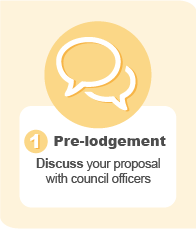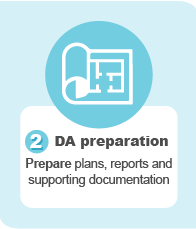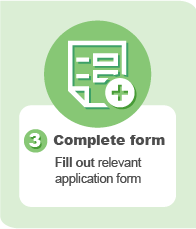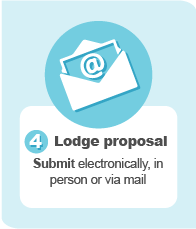Development application process
The development application (DA) process can be overwhelming and confusing. That's why we've developed a simple guide to the DA process for your next build or renovation.
 |  |  |  |
Before you begin
Before you undertake any development or building works, you will need to determine if you need approval from Council.
The type of consent or approval you require, if any, depends on the scale and potential impacts of your development on adjoining properties. See our table below on approval pathways for different types of development.
Assessment pathway
| Level of approval | Potential impact | Level of assessment | |
|---|---|---|---|
| Exempt development | No approval from Council | Minimal environmental / amenity impact | Must comply with pre-set legislative standards |
| Complying development | Approval by issue of complying development certificate by Council or accredited certifier | Predictable environmental / amenity impact | Must comply with pre-set legislative standards and conditions |
| Development consent | Council development consent through the development application process | Could be major environmental / amenity impact | Merit-based assessment |
Step 1 - Pre-lodgement
Before lodging a DA, you need to review planning policies that apply to your land, such as:
To see what local environmental planning constraints, applicable planning policies and permissible uses apply to your land or property, we recommend using the NSW Planning Viewer.
A simple DA process starts with pre-lodgement. Our pre-lodgement advice service helps you work towards a successful outcome as quickly and cost-effectively as possible. The benefits of pre-lodgement advice include:
- an early understanding of what you're trying to achieve
- agreement on what is required or possible on the proposed development site
- early access to professionals who may assess your application, saving you time and money in preparing your application.
Find out how to access our pre-lodgement advice service.
We recommend you talk to your neighbours and to any local community groups about your plans to help them understand your proposal.
Considering their concerns and seeking to compromise to achieve a satisfactory outcome may reduce the number of submissions opposing your application.
Prior to lodging a DA for the below types of development, email development.engineering@portstephens.nsw.gov.au to see if the site is located in a Stormwater Requirement Area (SRA).
- Dwelling house (including alterations and additions to existing)
- Secondary dwellings
- Attached dwellings
- Semi-detached dwellings
- Dual occupancies
- Two lot subdivision
If the site is in an SRA and the imperious area of the site is increasing, the following on-site detention /on-site infiltration requirements apply:
a. Stormwater/drainage plans prepared and certified by a suitably qualified professional are to be submitted which provides for an on-site detention system.
OR
b. Detention / storage tanks in accordance with BASIX requirements are to be provided, and
c. For every 100m2 of roof or impervious area collected an additional 2,000 litres detention / storage is to be provided.
OR
d. A 6000 litre detention tank (in addition to any BASIX requirements) provided for each dwelling.
Details of compliance with the above requirements must be provided with any DA submitted.
Step 2 - DA preparation
Giving us a complete application — with all required information and supporting documents — will save time and money for both you and our Council.
- The Supporting Documentation Guide (PDF 872KB) outlines the documentation and information you'll need to prepare your DA.
- Detailed information about lodgement requirements for certain types of developments can be found in the Port Stephens Council Development Control Plan 2014.
You may need to complete a physical commencement application form as part of your development application.
Step 3 - Lodgement
You're now ready to lodge your application online via the NSW Planning Portal. Find out more about how to lodge your application.
We have a statutory obligation to determine a DA within a certain time frame. To do this, we need all the relevant information - incomplete applications will not be accepted.
Once you've lodged your application with the NSW Planning Portal, we will determine if it is complete and what fees are payable.
Fees are charged in line with our Fees and Charges Schedule and are based on the estimated cost of works for the development.
Using our new smart fee service, you can get a quote by emailing devbuild@portstephens.nsw.gov.au or calling 02 4988 0255.
Council’s DA Tracker service allows you to follow the progress of your application online from lodgement to determination and view any relevant submissions in relation to the development.
Step 4 - Assessment
We must consider a number of statutory matters when determining your application, in line with Section 4.15 of the Environmental Planning and Assessment Act 1979 (EP&A Act). The assessment process is:
- Your application will be allocated to a development assessment officer.
- If necessary, they will refer your application to state government authorities and internal specialists for assessment.
- We will advertise your DA and notify nearby neighbours in line with the Community Participation Plan.
- You will receive an acknowledgment letter advising of the assessing officer for your application, who will be your point of contact.
Submissions received by our Council during the notification or exhibition period will consider the issues raised.
- Standard submissions including pro-forma letters prepared by 1 or more people, or on behalf of a group, will receive acknowledgement to the person or group which sent the submission. These are reported as 1 submission with 'X' number of signatures.
- Petitions will receive acknowledgement to each person who signed the covering letter accompanying the petition. These are reported as 1 petition with 'X' number of signatures.
Note: Where no contact information is provided on the submission, an acknowledgement letter or email will not be issued. The submitter will not be recorded in our record system or notified of Council consideration of the matter, or subsequent decisions.
- The assessing officer will compile all information and comments received during the notification and referral process.
- If information is missing, you will receive a request for additional information via the NSW Planning Portal. We will 'stop the clock' on the assessment time frame while additional information is submitted.
- Once all relevant information is available, the assessing officer will carry out a site inspection.
- They will evaluate your proposal’s compliance with development controls, statutory requirements and any relevant objections.
- A development assessment report will be completed and a recommendation made.
The application will be determined by Council officers under delegation from the General Manager and the elected council, unless:
- an elected member of Council requests the staff delegation be withdrawn and the DA be reported to Council for determination or
- the Group Manager of Development Services and/or Manager of Development Assessment and Compliance uses their discretion and judgment to determine that an application should be reported to Council.
Note: During assessment, the applicant may advise they are not providing any further information and request Council make a determination. Determinations of DAs under delegated authority are in accordance with set procedures.
The application may be determined by the Hunter and Central Coast Regional Planning Panel if it meets certain regionally significant development criteria, as identified in Schedule 7 of the State Environmental Planning Policy (State and Regional Development) 2011. In this case, Council officers will carry out the assessment of the proposal to be presented to the panel for determination at a public panel meeting.
Following determination, we will write to the applicant and provide a notice of determination (NOD) listing the conditions of consent or reasons for refusal. A copy of the stamped plans and other relevant documentation will also be provided. In accordance with Schedule 1, clause 20(2) of the EP&A Act, the NOD will outline the reasons for the determination and consideration of community views.
Where required, we will notify all persons who made a submission of the determination of that application.
The following SEPP1/Clause 4.6 variations have been approved by Council:
2023:
2022:
- Clause 4.6 Report - 1 October 2022 to 31 December 2022
- Clause 4.6 Report - 1 July 2022 to 30 September 2022
- Clause 4.6 Report - 1 April 2022 to 30 June 2022
- Clause 4.6 Report - 1 January 2022 to 31 March 2022
2021:
- Clause 4.6 Report — 1 Oct 2021 to 31 Dec 2021
- Clause 4.6 Report — 1 Apr 2021 to 30 Jun 2021
- Clause 4.6 Report — 1 Jan 2021 to 31 Mar 2021
2020:
- Clause 4.6 Report — 1 Oct 2020 to 31 Dec 2020
- Clause 4.6 Report — 1 Jul 2020 to 30 Sep 2020
- Clause 4.6 Report — 1 Apr 2020 to 30 Jun 2020
- Clause 4.6 Report — 1 Jan 2020 to 31 Mar.2020
2019:
- Clause 4.6 Report — 01 Oct 2019 to 31 Dec 2019
- Clause 4.6 Report — 01 Jul 2019 to 30 Sep 2019
- Clause 4.6 Report — 01 Apr 2019 to 30 Jun 2019
- Clause 4.6 Report — 01 Jan 2019 to 31 Mar 2019
2018:
- Clause 4.6 Report — 01 Oct 2018 to 31 Dec 2018
- Clause 4.6 Report — 01 Jul 2018 to 30 Sep 2018
- Clause 4.6 Report — 01 Apr 2018 to 30 Jun 2018
- Clause 4.6 Report — 01 Jan 2018 to 31 Mar 2018
2017:
What's next?
If consent is granted for your development, a schedule of conditions will be issued with the notice of determination. The conditions must be complied with and should be read in conjunction with the stamped approved plans.
Below is an overview of the next steps in the DA process - there may be other applications, certificates, registrations or notices not listed.
Before undertaking any building or construction work, you will need to obtain a construction certificate:
- A construction certificate application may be lodged at the same time as a development application or at a later date.
- A construction certificate can be lodged and issued concurrently with the DA, or once consent for the DA has been granted and any relevant conditions have been met.
- It certifies that the detailed construction plans and development specifications are consistent with the development consent and also comply with the Building Code of Australia. Civil works associated with subdivisions may also require construction certificate approval.
How to get a construction certificate:
- You can obtain the certificate from either Council or an accredited private certifier.
- We currently hold a market share of over 80% of certification works in our Local Government Area.
- Contact Council’s certification team on 02 4988 0115 to find out about our competitive certification services and fees.
- All relevant fees (including the Long Service Levy if applicable) must be paid prior to issue of a construction certificate.
An occupation certificate authorises the occupation and use of a new building, or a change in use of an existing building.
This building, or a nominated part of the building, must be suitable and safe to be occupied in line with the Building Code of Australia.
For more information, refer to the building certification page or call Council's Building Surveyors on 02 4988 0115.
Once a DA consent for a subdivision is received, a subdivision certificate is required to authorise the registration of the subdivision plan for lodgement with NSW Land Registry Services.
A registered surveyor must prepare a plan to be lodged with Council with a subdivision certificate application form, relevant fee and supporting documentation.
This certifies that the subdivision has been completed in accordance with the consent and any subdivision work has been completed in accordance with the construction certificate, as set out in section 109C(1)(d) of the EP&A Act. This may include civil construction works such as rights-of-carriageway, roads, footpaths, water and sewerage asset construction.
Your application may require approval for one or more of the matters listed under Section 68 of the Local Government Act 1993 such as:
- installing a manufactured home or mobile dwelling
- installing or altering a waste treatment device
- operating a car park, caravan park or manufactured home estate
- conducting activities on community or public land.
If Section 68 activities are to be undertaken independently from a DA, a separate application form must be submitted to Council for approval. If the Section 68 works are to be carried out as part of a DA, a separate application form is not required however the appropriate box must be ticked on the DA form and relevant fees paid. Please call Council's Environmental Health Team on 02 4988 0255 for further information.
Your application may require approval under Section 138 of the Roads Act 1993 for works within the public road reserve including but not limited to:
- road pavement works
- kerb and gutter
- footway works
- vehicular access crossings
- drainage works.
A separate application form must be submitted to Council for approval for these works. Please contact Council's Engineering Section on 02 4988 0255 for further information.
You may apply to modify your development consent provided the proposed development as modified is still substantially the same development.
Section 4.55 of the EP&A Act sets out the requirements for modification of consents. There are several categories:
- s4.55(1) — to correct a minor error, mis-description or mis-calculation made by Council
- s4.55(1A) — for a modification that will have minimal environmental impact
- s4.55(2) — to modify the consent such as design changes or a deletion of a condition of consent
- s4.56AA(1) — to modify a consent handed down by the Land and Environment Court.
To modify a consent, you must do so via the NSW Planning Portal. If the proposed modification does not fall into one of the above categories, you may need to lodge a new development application.
Depending on the nature of the modification, different supporting documents will need to be supplied. Original supporting documentation that will be affected must be amended and provided with the modification application.
If an applicant is dissatisfied with Council’s determination of an application, they may request a review of a development application determination under section 8.2, 8.3, 8.4 and 8.5 of the EP&A Act, except for the following application types:
- complying development certificates
- designated development
- integrated development
- Crown development.
The review must be completed within 6 months of the determination of the application — it's advisable to lodge the application for review as soon as possible to allow Council time to reassess the application and conduct any required notification or advertising processes.
A review of a modification determination application (section 4.57 of the EP&A Act) must be lodged within 28 days of the date of the original decision. The request for a review under section 8.2 means the whole determination is open for review — if you are only concerned with one condition, it may be more appropriate to lodge a modification application (section 4.55).
A review can also be undertaken at an applicant’s request under section 8.2, 8.3 and 8.4 of the EP&A Act where Council does not accept a development application (that is, it is rejected and not determined). The application will be reconsidered by a person with a higher level of delegation than the original determination. A statement of support must be submitted with the application stating the reasons why Council should review its decision.
If you are dissatisfied with Council’s determination of a development application or Council has not determined the development application within the statutory time frame, you can lodge an appeal to the Land and Environment Court to determine the application.
An applicant has 6 months from the date of determination to lodge an appeal to the Land and Environment Court.
For more information, visit the NSW Land and Environment Court website.

